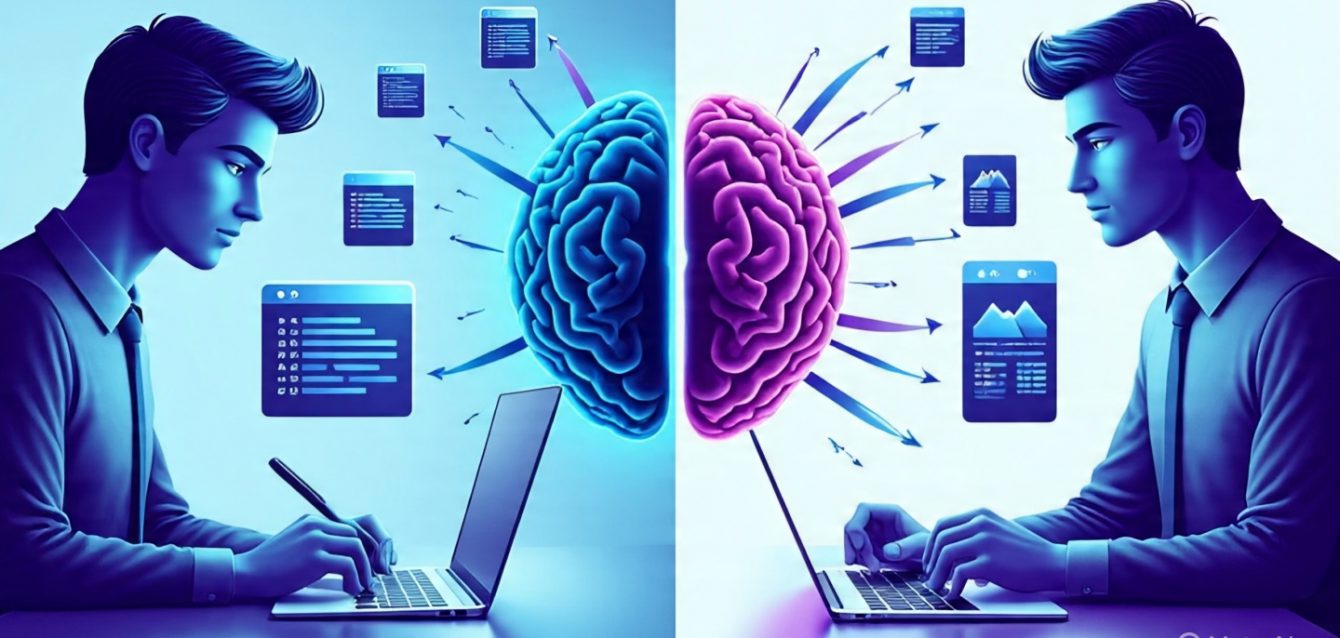Prompt Engineering vs. Context Engineering
Mastering Communication with Artificial Intelligence
PeopleWorks GPT - Advanced AI Insights
Prompt Engineering
The Art of Crafting the Perfect Question
Involves carefully designing and refining the instruction (the "prompt") we give to AI to guide it toward the desired response. It's a direct and specific dialogue.
Analogy:
Like a film director giving precise instructions to an actor on how to perform a scene.
Workflow
graph TD
A["User"] -->|"1. Designs detailed prompt"| B("Prompt Engineering")
B --> C{"AI Model"}
C -->|"2. Processes direct instruction"| D["Specific Response"]
subgraph Focus ["Focus: The Question"]
B
end
style A fill:#e0f2fe,stroke:#0284c7,stroke-width:2px
style C fill:#f3e8ff,stroke:#8b5cf6,stroke-width:2px
style D fill:#dcfce7,stroke:#16a34a,stroke-width:2px
style Focus fill:#f0f9ff,stroke:#0284c7,stroke-width:1px
Context Engineering
Building the World for AI
Focuses on providing AI with all the relevant background information so it can answer a simple question in an informed and accurate manner. The question isn't refined, but the available knowledge is.
Analogy:
Instead of just giving instructions, you hand the actor the complete script and character biography.
Workflow (Ex: RAG)
graph TD
subgraph Prep ["1. Prepare Knowledge"]
A["Database"]
B["Documents"]
C["APIs"]
end
subgraph Enrich ["2. Enrich Request"]
D("Retrieval System")
E["User with Simple Question"]
end
F{"AI Model"}
G["Informed Response"]
A --> D
B --> D
C --> D
E --> D
D -->|"Question + Relevant Context"| F
F --> G
style E fill:#e0f2fe,stroke:#0284c7,stroke-width:2px
style F fill:#f3e8ff,stroke:#8b5cf6,stroke-width:2px
style G fill:#dcfce7,stroke:#16a34a,stroke-width:2px
style Prep fill:#fef7ff,stroke:#a855f7,stroke-width:1px
style Enrich fill:#f0f9ff,stroke:#0284c7,stroke-width:1px
Head-to-Head Comparison
Prompt Engineering
- 🎯 Focus:
- The question. Polish the instruction to be clear and effective.
- 🏆 Objective:
- Guide the AI's reasoning.
- 💡 Ideal for:
- Quick tasks, creative generation, summaries, translations.
Context Engineering
- 🎯 Focus:
- The information. Provide an external "brain" with relevant data.
- 🏆 Objective:
- Feed the AI's knowledge.
- 💡 Ideal for:
- Document Q&A, support chatbots, data analysis.
The Perfect Synergy: Together They're Stronger
True power is unlocked by combining both disciplines. You use Context Engineering to give AI the right knowledge and Prompt Engineering to tell it exactly what to do with that knowledge.
graph TD
subgraph Context ["Context Engineering: The WHAT"]
A["External Knowledge Base"] --> B{"Retrieval System"}
end
subgraph Prompt ["Prompt Engineering: The HOW"]
C["User"] --> D["Detailed Prompt
Act as..., summarize...
in this format..."]
end
B -->|"Relevant Context"| E{"AI Model"}
D -->|"Precise Instruction"| E
E --> F["✨ Optimal Result ✨"]
style A fill:#c7d2fe,stroke:#4f46e5,stroke-width:2px
style D fill:#bfdbfe,stroke:#2563eb,stroke-width:2px
style E fill:#e9d5ff,stroke:#9333ea,stroke-width:3px
style F fill:#fef9c3,stroke:#eab308,stroke-width:3px
style Context fill:#312e81,stroke:#4f46e5,stroke-width:2px,color:#ffffff
style Prompt fill:#1e3a8a,stroke:#2563eb,stroke-width:2px,color:#ffffff
Advanced Techniques Revolutionizing the Field
Discover the latest innovations taking AI communication to the next level
🚀 Advanced Prompt Engineering
- Meta Prompting: Using prompts to generate better prompts
- Self-Consistency: Generate multiple responses and choose the most consistent
- Tree-of-Thought: Explore multiple reasoning pathways
- Emotional Stimuli: Add phrases like "this is very important to my career"
🧠 Cutting-Edge Context Engineering
- Memory Architecture: Semantic, episodic, and procedural memory
- Context Pruning: Intelligent compression up to 80%
- Multi-Modal Integration: Unification of text, audio, and images
- Temporal Knowledge Graphs: Dynamic context organization
Real Results: The Numbers Don't Lie
Data from real-world implementations demonstrating Context Engineering's superiority
📊 RAG vs Fine-tuning Comparison
Tools You Need to Know
Leading platforms transforming the AI landscape
🦜 LangChain Ecosystem
Leader in context management with 700+ integrations
- • Modular frameworks
- • Multi-agent orchestration
- • Production observability
🦙 LlamaIndex Platform
Specialist in retrieval optimization
- • 150+ data sources
- • 40+ vector databases
- • Multi-modal processing
🌲 Pinecone Vector DB
Leader in vector databases
- • Real-time indexing
- • Automatic scaling
- • Hybrid search
💰 The Market Is Exploding
Critical Mistakes You Must Avoid
Learn from common mistakes to accelerate your success
❌ Prompt Engineering Pitfalls
"Prompt Novel" Syndrome
Excessively long and complex prompts that confuse more than help
Memory Expectations
Expecting AI to remember information from previous conversations
Fighting Hallucinations
Trying to solve hallucinations with just more rules in prompts
❌ Context Engineering Pitfalls
Information Overload
Providing too much irrelevant context that distracts from the objective
Context Poisoning
Allowing hallucinations to contaminate the context window
Poor Context Hygiene
Not maintaining clean and organized long-term context
✅ Your Action Plan
- 1. Start with context: Before writing prompts, ask "What information does the AI need to succeed?"
- 2. Build incrementally: Don't dump all information at once. Add context as needed
- 3. Layer your prompts: Use simple, clear prompts that leverage your context setup
- 4. Maintain state: Keep conversation histories and interim results as part of your context
- 5. Iterate on both levels: Refine both your context architecture AND your prompting
The Future Is Already Here
Emerging trends that will define the next decade of AI
🤖 Agentic AI
Autonomous systems requiring sophisticated context management for multi-step tasks
🧠 Intelligent Curation
Dynamic context window adjustment based on task complexity
🔗 Quantum Memory
Exponentially larger memory storage for context retention
🔮 Predictions for 2025-2026
Context Engineering will become as fundamental as traditional programming
AI systems that self-engineer their own context requirements
Unified multi-modal context windows (text, audio, video, sensory)
Shared memory between agents for distributed intelligence
Ready to Master the Future of AI?
Don't get left behind in the Context Engineering revolution. The future belongs to those who master this discipline.
🎯 Your Next Steps
✅ Experiment with LangChain or LlamaIndex to build your first RAG system
✅ Implement conversational memory in your AI applications
✅ Measure performance: completion rates, context relevance, token efficiency
✅ Iterate on both context architecture and prompts
✅ Stay updated with the latest research and tools
The competitive advantage isn't in crafting perfect prompts,
but in building intelligent systems that dynamically orchestrate the right information.
PeopleWorks GPT - Empowering organizations with advanced AI insights
Semantic Layer

Software engineer, passionate about data and information, immersed in a total transformation with artificial intelligence.
